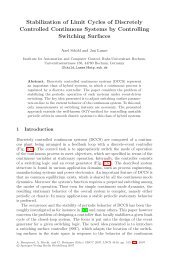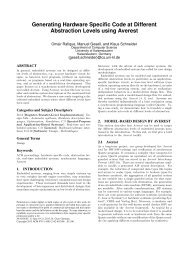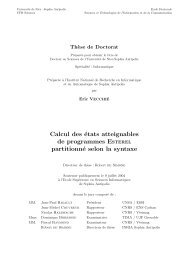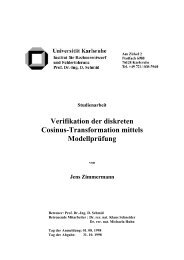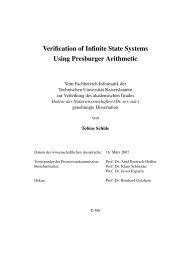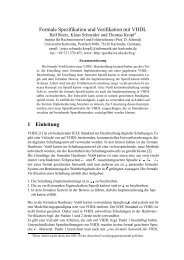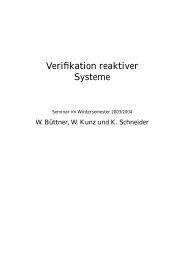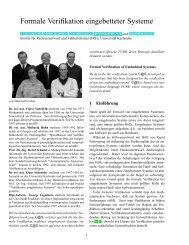Generation of permutations for {SIMD} processors - Embedded ...
Generation of permutations for {SIMD} processors - Embedded ...
Generation of permutations for {SIMD} processors - Embedded ...
Create successful ePaper yourself
Turn your PDF publications into a flip-book with our unique Google optimized e-Paper software.
ld x<br />
ld x<br />
WR CSE<br />
st y<br />
RD CSE<br />
Figure 5. <strong>SIMD</strong> DFG <strong>of</strong> 8-point bit-reversal.<br />
register only in the order it was written to the register. Thus, a P-<br />
node is inserted after a node reading the common subexpression,<br />
as shown in Figure 4. After insertion <strong>of</strong> the P-nodes, orderings <strong>of</strong><br />
the <strong>SIMD</strong> groups that read CSEs correspond directly to orderings<br />
<strong>of</strong> the <strong>SIMD</strong> groups that write CSEs. The reordering patterns <strong>of</strong> the<br />
P-nodes are shown in the Figure 4 as (0,0,2,2) and (1,1,3,3).<br />
Consider another example. This is a code <strong>for</strong> bit-reversed reordering<br />
<strong>of</strong> an array <strong>of</strong> length 8.<br />
y[0] = x[0];<br />
y[1] = x[4];<br />
y[2] = x[2];<br />
y[3] = x[6];<br />
y[4] = x[1];<br />
y[5] = x[5];<br />
y[6] = x[3];<br />
y[7] = x[7];<br />
The <strong>SIMD</strong> DFG <strong>of</strong> this code is shown in Figure 5. Here, each<br />
store <strong>SIMD</strong> group depends on two load <strong>SIMD</strong> groups. Thus, a P-<br />
node is inserted <strong>for</strong> each store group, and each load <strong>SIMD</strong> group<br />
creates a common subexpression read by the two P-nodes. The<br />
<strong>SIMD</strong> DFG after insertion <strong>of</strong> the needed P-nodes and common<br />
subexpression nodes is shown in Figure 6.<br />
In the previous example, the P-nodes had one or two source<br />
<strong>SIMD</strong> groups and produced results <strong>for</strong> only one <strong>SIMD</strong> group. A<br />
more general P-node can have N source <strong>SIMD</strong> groups and can also<br />
produce results <strong>for</strong> K <strong>SIMD</strong> groups. Such P-nodes are designated as<br />
P N→K . They are discovered while grouping the operations. When<br />
<strong>for</strong> some <strong>SIMD</strong> group its operands come from more than one <strong>SIMD</strong><br />
group, a P-node is inserted that reads all relevant <strong>SIMD</strong> groups<br />
and feeds its output into the current <strong>SIMD</strong> group. If some <strong>of</strong> the<br />
source <strong>SIMD</strong> registers <strong>of</strong> two P-nodes are the same, the P-nodes are<br />
combined, because one P N→K data reordering can be implemented<br />
more efficiently than K P M→1 data reorderings.<br />
When a P-node is factored into permutation instructions from<br />
the target ISA (see Section 5), the DFG <strong>of</strong> the solution is inserted<br />
into the <strong>SIMD</strong> DFG. If the DFG <strong>of</strong> the P-node is not a tree, it is<br />
split into trees, and each tree is inserted into the <strong>SIMD</strong> DFG. This<br />
may happen if the P-node decomposition consists <strong>of</strong> more than one<br />
permutation instruction and more than one <strong>of</strong> those instructions<br />
read some P-node source.<br />
4. <strong>SIMD</strong> Permutations<br />
P−nodes<br />
To generate a <strong>SIMD</strong> instruction, the operations in the <strong>SIMD</strong> group<br />
need to be assigned to specific positions in the <strong>SIMD</strong> instruction.<br />
This assignment is called an ordering. In the example in Figure 2,<br />
the operations are easily ordered so that <strong>for</strong> all operations the results<br />
are read in the same order they are produced. If a different ordering<br />
were chosen <strong>for</strong> the <strong>SIMD</strong> group <strong>of</strong> arithmetic operations, such ordering<br />
assignment would require data reordering, and permutation<br />
instructions would have to be inserted into the <strong>SIMD</strong> DFG. For<br />
some <strong>SIMD</strong> DFGs, it may be impossible to order the operations in<br />
the <strong>SIMD</strong> groups so that <strong>for</strong> all edges in the <strong>SIMD</strong> DFG the results<br />
are produced in the same order that they are used. In such cases, it<br />
is necessary to insert permutation instructions between the groups<br />
with different orderings.<br />
Figure 7 shows four <strong>SIMD</strong> groups. Elements <strong>of</strong> each <strong>SIMD</strong><br />
group i are somehow ordered. Let’s designate that ordering assignst<br />
y<br />
Figure 6. <strong>SIMD</strong> DFG <strong>of</strong> 8-point bit-reversal with P-nodes.<br />
ment as A i . The edge between two groups corresponds to a bunch<br />
<strong>of</strong> data dependences, and individual dependences are not shown.<br />
The permutation that needs to be per<strong>for</strong>med along edge (i, j) from<br />
<strong>SIMD</strong> group i to <strong>SIMD</strong> group j is shown as P i→ j .<br />
Initially, only <strong>SIMD</strong> groups <strong>of</strong> memory operations have orderings,<br />
which are determined by their effective addresses. These orderings<br />
are fixed and cannot be changed. For other nodes in the<br />
<strong>SIMD</strong> DFG, their orderings can be selected arbitrarily with the goal<br />
<strong>of</strong> finding an ordering assignment that minimizes the total cost <strong>of</strong><br />
<strong>permutations</strong>, where the cost <strong>of</strong> a permutation can be, <strong>for</strong> example,<br />
the number <strong>of</strong> instructions needed to per<strong>for</strong>m the permutation, or<br />
the estimated energy consumed by these instructions.<br />
Without constraints on the orderings to be considered in search<br />
<strong>of</strong> the best ordering assignment, each <strong>SIMD</strong> group without a fixed<br />
ordering assignment (<strong>SIMD</strong> groups <strong>of</strong> operations other than memory<br />
operations) can have W! different orderings, where W is the<br />
number <strong>of</strong> operations in the <strong>SIMD</strong> instructions, or the width <strong>of</strong><br />
<strong>SIMD</strong> operations. Thus, <strong>for</strong> the entire <strong>SIMD</strong> DFG there exist<br />
W! N f ree<br />
choices <strong>of</strong> ordering assignments, where N f ree is the number<br />
<strong>of</strong> <strong>SIMD</strong> nodes without constraints on ordering selection. Such a<br />
problem can only be solved directly <strong>for</strong> very small widths <strong>of</strong> <strong>SIMD</strong><br />
operations and small <strong>SIMD</strong> trees.<br />
4.1 Orderings Propagation<br />
To allow the problem to scale better with the <strong>SIMD</strong> width and<br />
DFG size, some constraints must be imposed on the choices <strong>of</strong> the<br />
orderings <strong>of</strong> operations in the <strong>SIMD</strong> groups. It seems reasonable<br />
to assume that <strong>for</strong> an ordering assignment to the <strong>SIMD</strong> groups that<br />
minimizes total permutation costs, each node in the <strong>SIMD</strong> DFG<br />
will have the same ordering as at least one <strong>of</strong> its neighbors in the<br />
graph. Thus, the idea is to take known orderings <strong>of</strong> <strong>SIMD</strong> groups<br />
<strong>of</strong> memory operations and propagate them through the <strong>SIMD</strong> DFG.<br />
ld x<br />
Op<br />
st y<br />
A1<br />
P(1−>3)<br />
P(3−>4)<br />
Figure 7. <strong>SIMD</strong> Group Ordering.<br />
A2<br />
P(2−>3)<br />
A3<br />
A4<br />
LCTES’05, 5 2005/4/16<br />
151




